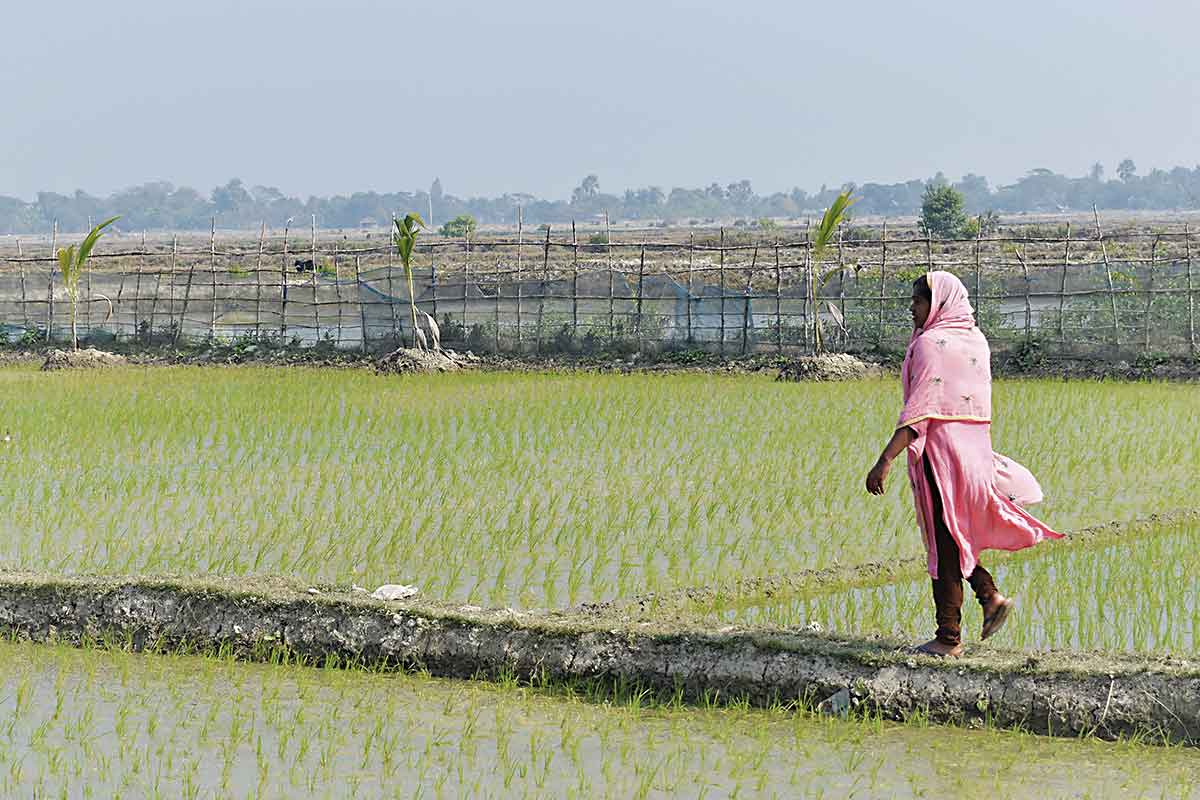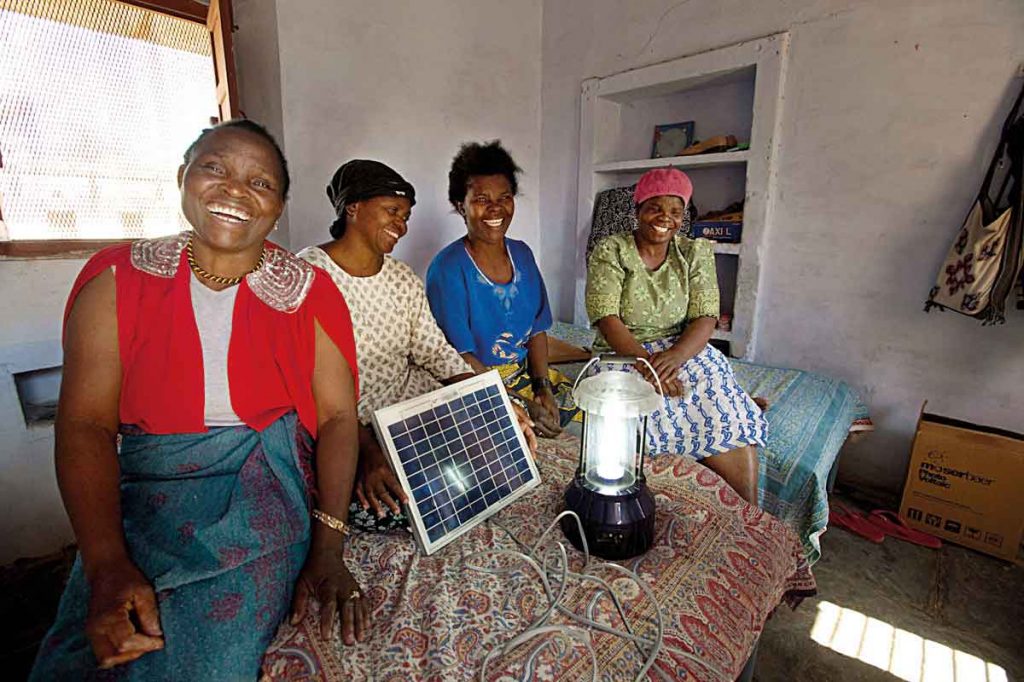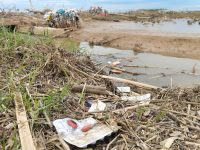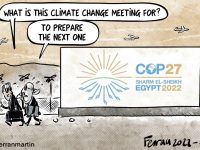Climate change is not equal to all
The contribution of feminist studies to climate change research

The impacts of climate change on people are not homogeneous, with some social groups being more heavily affected than others. This is due to the existence of a differential and contextual vulnerability that most often is related to inequality. In this sense, gender is a key axis of social inequality that intersects with other systems of power and marginalization to cause unequal experiences of climate change vulnerability and adaptive capacity. Thus, a gender analysis in climate change research examines structures and relationships of power. In this article, I provide some examples of differential impacts of climate change and how feminist studies make visible the underlying causes of vulnerability as well as the agency of marginalised actors to propose alternatives.
Keywords: climate change adaptation, maladaptation, feminist research, intersectionality, contextual vulnerability.
Climate change is a human-induced physical phenomenon, whose impacts are experienced by ecosystems and people. As an example, 80 % of the ecological processes that underpin ecosystem functioning and the associated support services to people are already affected by climate change. With approximately one million of species facing extinction risk, climate change adds to other human-induced changes, including land use change, demographic, or socio-economic changes, all of them threatening the very ability to live on Earth.
Social differences and climate change
The impacts of climate change on people are varied and not homogeneous. Some impacts are more experienced by some social groups than others. For instance, heat waves hit more strongly to old people (Carter et al., 2014), while low income and vulneralised people are more heavily impacted by climate change in general, and extreme events in particular. Let us think for instance on how poverty, ethnic minority, age, disability, or gender influenced the way different social groups were impacted by the Hurricane Katrina in 2005 (Laska & Morrow, 2006). This differential impact is due to structural conditions in our societies and requires of specific analysis of the underlying conditions that make some people more vulnerable than others for the same hazard. In the vulnerability literature this is known as contextual vulnerability. Contextual vulnerability analyses how climate variability and change occur in the context of political, institutional, economic, and social structures and changes, which interact dynamically with contextual conditions. Eriksen et al. (2015) argue that an understanding of the social dynamics of vulnerability is required as a starting point to address the political nature of climate change. Most often, differential vulnerability to climate change is related to inequality. Here, gender and feminist studies are of extreme relevance. For instance, feminist political ecology studies the underlying causes of inequality stemming from historical, political, economic, demographic, and environmental contexts and the role of spatial and embodied practices in constituting gendered subjectivity (Nightingale, 2011). In this sense, gender is a key axis of social inequality that intersects with other systems of power and marginalization – including ethnic origin, culture, class/socioeconomic status, location, disability, sexuality, and age – to cause unequal experiences of climate change vulnerability and adaptive capacity. In sum, through gender analysis we examine structures and relationships of power, and using a framework of intersectionality, we integrate gender into climate change research in order to recognize overlapping and interconnected systems of power (Djoudi et al., 2016) which, ultimately, create particular inequitable experiences of climate change vulnerability and adaptation.
«The impacts of climate change on people are varied and not homogeneous. Some are more experienced by some social groups than others»
Vulnerability is composed of three main variables: exposure to a given hazard, in this case climate change; sensitivity, that is, the degree of the impacts; and adaptation, responses to cope and adapt to the hazard and the impacts. Socially constructed gender difference, particularly sexual division of labour and care work allocated to women, affect all three. Exposure to extreme events differ among men and women in different territories, leading to differential patterns of mortality. Where men are expected to be brave and engage in life-saving actions, this can increase their likelihood of mortality, as described in Vietnam during flooding (United Nations Viet Nam & Oxfam Viet Nam, 2009). Social norms can also exclude women from learning to swim, as in Bangladesh (Röhr, 2006), or expect women to stay in the house even during floods, as shown in Nicaragua (Bradshaw & Linneker, 2009), and so women, in those contexts, are more vulnerable to flooding. Gender inequalities also manifest themselves in gendered livelihood impacts and feminisation of responsibilities. For instance, while both men and women experience increases in productive roles due to climate change, it has been reported that most often it is only women experiencing increased reproductive roles (Vincent et al., 2014) with the highest workload coming from care and domestic activities «associated» to them. Adaptive capacity also differs, particularly due to differential access to the social and environmental resources required for adaptation, in other words, due to inequality in rights-based resource access, established through formal and informal institutions. In many contexts, it is well established that women have poorer access than men to financial resources, land, education, health, and other basic rights. Further drivers of gender inequality result from social exclusion from decision-making processes and labour markets, making women in particular less able to cope with and adapt to climate change impacts.

It is imperative for adaptation policies and actions to be gender-sensitive and transformative, and not to increase women’s work burden or reinforce stereotypes. In the picture, participants from Liberia and Malawi in a six-month solar engineering course. / Photo: UN Women/Gaganjit Singh
It is only recently that a gender approach has been introduced in climate change research. In the IPCC fourth assessment report (AR4) published in 2007 gender was only mentioned, and it was in the fifth assessment (AR5) where a deeper analysis of the contextual vulnerability through the lens of gender was for the first time performed (Vincent et al., 2014). The focus was mostly on women as victims, mostly women from the global South, a common feature of the literature by then (Arora-Jonsson, 2011). In the current sixth IPCC cycle (AR6) the gender analysis is widely spread, both in the global report and in the associated three special reports: the 1.5 °C report (SR1.5), the oceans report (SROCC) and the land report (SRCCL). The focus has been expanded towards intersectionality and women and marginalised groups are presented as political subjects with agency capacity. Whatever the focus, they all show how relevant gender analysis is in revealing impacts which were not previously assessed, or the barriers that impede people to overcome such impacts, blocking the development of strategic policies and actions that take this into consideration (gender-sensitive) or rather, that aim to change the roots of these unequal impacts and responses (gender transformative). In sum, what it is clear now is that in developing adaptation actions to climate change it is important to consider the different analytical categories (e.g., gender, class, age, ethnicity) that help to explain the unequal social consequences of climate change, to characterise marginalised social groups, understand contextual vulnerability, and identify differential responses at particular locations.
Women and climate change adaptation
Considering this contextual vulnerability is of extreme relevance in developing adaptation policies and actions. As Eriksen et al. (2015) pointed out:
…all adaptation actions will influence social relations, governance and distribution of resources in any given population or place. Yet not all these changes are desirable to everyone. Whether and how adaptation addresses social injustice and fundamental inequities in resource distribution will always be disputed, and dependent on specific knowledge, authorities, and subjectivities. (Eriksen et al., 2015)
With this focus in mind, it is then imperative that adaptation policies and actions, should be, at least, gender-sensitive, and preferably gender-transformative. Technology, policy, and programs that exacerbate women’s workloads or reinforce gender stereotypes, or which fail to recognize and value the contributions women already make may further marginalize them. Below, I present some examples in the AFOLU sector (Agriculture, Forestry and Land Use) that inadvertently increase gender inequality. For instance, conservation agriculture or sustainable land management, which have been recognised as sustainable adaptation options with synergies with mitigation, may increase women’s average working hours (Wekesah et al., 2019). Evidence shows that in some cases, adaptation interventions focused on cash-crops as a way to increase economic return have reduced women participation in household decision-making in those places where the crops associated to women are those for domestic consumption. In forest conservation and restoration, it has been shown that too restricted rules of REDD+ that do not include traditional uses from local communities can hamper women and girls traditional activities in National Parks and they may get even punished (Benjaminsen & Kaarhus, 2018). Furthermore, women work in reforestation projects may end up subsidising carbon projects – primarily aimed at reducing greenhouse gas emissions – when the incorporation of women into social programs creates unwaged «women work» that increases their workload but fails to increase their economic opportunities (Gay-Antaki, 2016).
«Conservation agriculture or sustainable land management may increase women’s average working hours»
An intersectional approach to this analysis adds even more complexity so we can find that even well-intentioned policies may increase differences among social groups. In Burkina-Faso, REDD+ programs, after performing a simple gender analysis, observed non-timber forest products were mostly associated to women, and thus, introduced these products as part of the conservation activities included in the program in order to increase their income. However, an intersectional approach showed that groups of less-wealthy women were excluded and their resource access was as a result not protected by local institutions, increasing the difference between wealthy and non-wealthy women (Westholm, 2016). It is indeed very often that the poor frequently bear indirect impacts of adaptation interventions. This is the case of flood protection barriers, which may displace flooding away from high income populations to poor populations (Mustafa & Wrathall, 2011). Even worse is the case in which adaptation options are purposely designed to benefit wealthy groups. A study in Bangladesh revealed how local elites and donors used adaptation projects as a lever to push vulnerable populations away from their agrarian livelihoods (perceived as backwards) and into uncertain urban wage labour (Paprocki, 2018). These types of outcomes are categorised as maladaptation, interventions that increase rather than decrease vulnerability, and undermine or eradicate future opportunities for adaptation and development. By implicitly limiting the concept of adaptation to a «rational» policy process, people are presented as «recipients of adaptation», instead of active agents in shaping their destinies.
But a gender perspective also considers knowledge, participation, and women’s rights and responsibilities. Under this perspective, women are active agents in bringing about equitable climate change solutions (beyond the stereotype of women as «vulnerable») for transformational adaptation and creation of emancipatory actions. For example, women in socially disadvantaged groups have engaged in new livelihood activities challenging market economy and gendered roles, after adult men out-migrate (Djoudi & Brockhaus, 2011). Agroecology-based interventions that include social aspects in the intervention or training have also shown to empower women and promote gender equity both in rural (Oliver, 2016) and urban areas (Carvalho & Bógus, 2020). Collective action and agency of women in farming households, including widows, have led to prevention of crop failure, reduced workload, increased nutritional intake, increased sustainable water management, and diversified and increased income (Andersson & Gabrielsson, 2012).
Conclusion
In sum, we need to understand and acknowledge that vulnerability and adaptation are socio-political processes. Understanding the redistributive impacts of adaptation policies and strategies is extremely important and noy yet well understood, mostly if we introduce different scales (from local to global) in the analysis. As Atteridge and Remling (2017) pointed out: «This is not only an equity issue, but also – as others have argued – may present a risk to systemic stability or resilience at the global level». Understanding also how deliberate transformation processes take adaptation to climate change, and its transformative and emancipatory potential, is essential to change the current structural conditions that impede a more equal, just, and fair adaptation to climate change to all people and social groups and here, feminist studies offer conceptual and methodological tools which can contribute to advance knowledge towards this aim.
References
Andersson, E., & Gabrielsson, S. (2012). ‘Because of poverty, we had to come together’: Collective action for improved food security in rural Kenya and Uganda. International Journal of Agricultural Sustainability, 10(3), 245–262. https://doi.org/10.1080/14735903.2012.666029
Arora-Jonsson, S. (2011). Virtue and vulnerability: Discourses on women, gender and climate change. Global Environmental Change, 21(2), 744–751. https://doi.org/10.1016/j.gloenvcha.2011.01.005
Atteridge, A., & Remling, E. (2017). Is adaptation reducing vulnerability or redistributing it? Wiley Interdisciplinary Reviews: Climate Change, 9(1), e500. https://doi.org/10.1002/wcc.500
Benjaminsen, G., & Kaarhus, R. (2018). Commodification of forest carbon: REDD+ and socially embedded forest practices in Zanzibar. Geoforum, 93, 48–56. https://doi.org/10.1016/j.geoforum.2018.04.021
Bradshaw, S., & Linneker, B. (2009). Gender perspectives on disaster reconstruction in Nicaragua: Reconstructing roles and relations? In E. Enarson & D. P. G. Chakrabarti (Eds.), Women, gender and disaster: Global issues and initiatives (1a edición, pp. 75–88). SAGE Publications Pvt. Ltd. http://doi.org/10.4135/9788132108078.n6
Carter, T. R., Fronzek, S., Inkinen, A., Lahtinen, I., Lahtinen, M., Mela, H., O’Brien, K. L., Rosentrater, L. D., Ruuhela, R., Simonsson, L., & Terama, E. (2014). Characterising vulnerability of the elderly to climate change in the Nordic region. Regional Environmental Change, 16(1), 43–58. https://doi.org/10.1007/s10113-014-0688-7
Carvalho, L. M. D., & Bógus, C. M. (2020). Gender and social justice in urban agriculture: The network of agroecological and peripheral female urban farmers from São Paulo. Social Sciences, 9(8), 127. https://doi.org/10.3390/socsci9080127
Djoudi, H., & Brockhaus, M. (2011). Is adaptation to climate change gender neutral? Lessons from communities dependent on livestock and forests in northern Mali. International Forestry Review, 13(2), 123–135. https://doi.org/10.1505/146554811797406606
Djoudi, H., Locatelli, B., Vaast, C., Asher, K., Brockhaus, M., & Basnett Sijapati, B. (2016). Beyond dichotomies: Gender and intersecting inequalities in climate change studies. Ambio, 45(S3), 248–262. https://doi.org/10.1007/s13280-016-0825-2
Eriksen, S. H., Nightingale, A. J., & Eakin, H. (2015). Reframing adaptation: The political nature of climate change adaptation. Global Environmental Change, 35, 523–533. https://doi.org/10.1016/j.gloenvcha.2015.09.014
Gay-Antaki, M. (2016). “Now We Have Equality”: A feminist political ecology analysis of carbon markets in Oaxaca, Mexico. Journal of Latin American Geography, 15(3), 49–66. https://doi.org/10.1353/lag.2016.0030
Laska, S., & Morrow, B. H. (2006). Social vulnerabilities and hurricane Katrina: An unnatural disaster in New Orleans. Marine Technology Society Journal, 40(4), 16–26. https://doi.org/10.4031/002533206787353123
Mustafa, D., & Wrathall, D. (2011). Indus basin floods of 2010: Souring of a Faustian bargain? Water Alternatives, 4(1), 72–85. http://www.water-alternatives.org/index.php/volume4/v4issue1/127-a4-1-5/file
Nightingale, A. J. (2011). Bounding difference: Intersectionality and the material production of gender, caste, class and environment in Nepal. Geoforum, 42(2), 153–162. https://doi.org/10.1016/j.geoforum.2010.03.004
Oliver, B. (2016). “The Earth gives us so much”: Agroecology and rural women’s leadership in Uruguay. Culture, Agriculture, Food and Environment, 38(1), 38–47. https://doi.org/10.1111/cuag.12064
Paprocki, K. (2018). Threatening dystopias: Development and adaptation regimes in Bangladesh. Annals of the American Association of Geographers, 108(4), 955–973. https://doi.org/10.1080/24694452.2017.1406330
Röhr, U. (2006). Gender and climate change. Tiempo, 59, 3–7. https://www.preventionweb.net/files/9739_tiempo59low.pdf
United Nations Viet Nam & Oxfam Viet Nam. (2009). Responding to climate change in Vietnam. Opportunities for improving gender equality. https://ciaotest.cc.columbia.edu/wps/oxfam/0018939/f_0018939_16199.pdf
Vincent, K. E., Tschakert, P., Barnett, J., Rivera-Ferre, M. G., & Woodward, A. (2014). Cross-chapter box on gender and climate change. In C. B. Field, V. R. Barros, D. J. Dokken, K. J. Mach, M. D. Mastrandrea, T. E. Bilir, M. Chatterjee, K. L. Ebi, Y. O. Estrada, R. C. Genova, B. Girma, E. S. Kissel, A. N. Levy, S. MacCracken, P. R. Mastrandrea, & L. L. White (Eds.), Climate change 2014: Impacts, adaptation, and vulnerability. Part A: Global and sectoral aspects. Contribution of Working Group II to the Fifth Assessment Report of the Intergovernmental Panel on Climate Change (pp. 105–107). Cambridge University Press.
Wekesah, F. M., Mutua, E. N., & Izugbara, C. O. (2019). Gender and conservation agriculture in sub-Saharan Africa: A systematic review. International Journal of Agricultural Sustainability, 17(1), 78–91. https://doi.org/10.1080/14735903.2019.1567245
Westholm, L. (2016). Fruits from the forest and the fields: Forest conservation policies and intersecting social inequalities in Burkina Faso’s REDD+ program. International Forestry Review, 18(4), 511–521. https://doi.org/10.1505/146554816820127578





